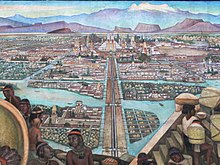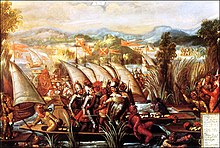Aztec period
The city now known as Mexico City was founded by the Mexica people, later known as the Aztecs, in 1325. The old Mexica city is now referred to as Tenochtitlan. The Mexica were one of the last of the Nahuatl-speaking peoples who migrated to this part of the Valley of Mexico after the fall of the Toltec Empire. Their presence was resisted by the peoples who were already in the valley, but the Mexica were able to establish a city on a small island on the western side of Lake Texcoco. The Mexica themselves had a story about how their city was founded, after being led to the island by their principal god, Huitzilopochtli. According to the story, the god indicated their old home with a sign, an eagle perched on a nopal cactus with a snake in its beak. Between 1325 and 1521, Tenochtitlan grew in size and strength, eventually dominating the other city-states around Lake Texcoco, and in the Valley of Mexico. When the Spaniards arrived, the Aztec Empire reached much of Mesoamerica, touching both the Gulf of Mexico and the Pacific Ocean. Scholars estimate that between 200,000 and 250,000 people lived in Tenochtitlan in 1500, more than four times the population of London at that time.
Spanish conquest of Tenochtitlán
After landing in Veracruz, Hernán Cortés heard about the great city and the long-standing rivalries and grievances against it. Although Cortés came to Mexico with a very small army, he was able to persuade many of the other native peoples to help him destroy Tenochtitlan. Cortés first saw Tenochtitlán on 8 November 1519. Upon viewing it for the first time, Cortés and his men were stunned by its beauty and size. The Spaniards marched along the causeway leading into the city from Iztapalapa. Although Montezuma came out from the center of Tenochtitlán to greet them and exchange gifts, the camaraderie did not last long. Cortés put Montezuma under house arrest, hoping to rule through him. Tensions increased until, on the night of June 30, 1520 – during a struggle commonly known as "La Noche Triste" – the Aztec revolted against the Spanish intrusion and managed to capture or drive out the Europeans and their Tlaxcalan allies. Cortés regrouped at Tlaxcala. The Aztecs thought the Spaniards were permanently gone. They elected a new king, Cuitláhuac, but he died after a few months due to smallpox; the next king was Cuauhtémoc. Cortés decided to lay siege to Tenochtitlán in May 1521. For three months, the city suffered from the lack of food and water as well as the spread of smallpox brought by the Europeans. Cortés and his allies landed their forces in the south of the island and fought their way through the city, street by street, and house by house. Finally, Cuauhtémoc had to surrender in August 1521.
City's rebuilding as Mexico City
The Spaniards practically razed Tenochtitlán. Cortés first settled in Coyoacán, but decided to rebuild the Aztec site to erase all traces of the old order. Cortés did not establish an independent, conquered territory under his own personal rule, but remained loyal to the Spanish crown. The first viceroy of the new domain arrived in Mexico City fourteen years later. By that time, the city had again become a city-state, having power that extended far beyond the city's established borders. Although the Spanish preserved Tenochtitlán's basic layout, they built Catholic churches over the old Aztec temples and claimed the imperial palaces for themselves. Tenochtitlán was renamed "Mexico", its alternative form name, as the Spanish found this easier to say.
Growth of the colonial city
The city grew as the population did, coming up against the lake's waters. The 16th century saw a proliferation of churches, many of which can still be seen today in the historic center. Economically, Mexico City prospered as a result of trade. Unlike Brazil or Peru, Mexico had easy contact with both the Atlantic and Pacific worlds. Although the Spanish crown tried to completely regulate all commerce in the city, it had only partial success.
The concept of nobility flourished in New Spain in a way not seen in other parts of the Americas. Spaniards encountered a society in which the concept of nobility mirrored that of their own. Spaniards respected the indigenous order of nobility and added to it. In the ensuing centuries, a noble title in Mexico did not mean one exercised great political power as one's power was limited even if the accumulation of wealth was not. The concept of nobility in Mexico was not political but rather a very conservative Spanish social one, based on proving the worthiness of the family. Most of these families proved their worth by making fortunes in New Spain outside of the city itself, then spending the revenues in the capital, building churches, supporting charities and building extravagant palatial homes. The craze to build the most opulent home possible reached its height in the last half of the 18th century. Many of these homes can still be seen today, leading to Mexico City's nickname of "The city of palaces" given by Alexander Von Humboldt.
The Grito de Dolores ("Cry of Dolores") also known as El Grito de la Independencia ("Cry of Independence"), uttered from the small town of Dolores, near Guanajuato on September 16, 1810 is the event that marks the beginning of the Mexican War of Independence and is the most important national holiday observed in Mexico. The "Grito" was the battle cry of the Mexican War of Independence by Miguel Hidalgo y Costilla, a Roman Catholic priest.Hidalgo and several criollos were involved in a planned revolt against the Spanish colonial government, and the plotters were betrayed. Fearing his arrest,[1] Hidalgo commanded his brother Mauricio, as well as Ignacio Allende and Mariano Abasolo to go with a number of other armed men to make the sheriff release the pro-independence inmates there on the night of 15 September. They managed to set eighty free.[2] Around 6:00 am September 16, 1810, Hidalgo ordered the church bells to be rung and gathered his congregation. Flanked by Allende and Juan Aldama, he addressed the people in front of his church, encouraging them to revolt. The Battle of Guanajuato, the first major engagement of the insurgency, occurred 4 days later. Mexico's independence would not be effectively declared from Spain in the Declaration of Independence of the Mexican Empire until September 27, 1821, after a decade of war. ref name="Iturbide">"Don Agustín de Iturbide". Retrieved 2008-10-20.</ref> Unrest followed for the next several decades, as different factions fought for control of Mexico. The Mexican Federal District was established by the new government and by the signing of their new constitution, where the concept of a federal district was adapted from the American constitution. Before this designation, Mexico City had served as the seat of government for both the State of Mexico and the nation as a whole. Texcoco and then Toluca became the capital of the state of Mexico. During the Mexican-American War, American forces marched toward Mexico City itself after capturing Veracruz. The invasion culminated with the storming of Chapultepec Castle in the city itself.The treaty of Guadalupe Hidalgo was signed in what is now the far north of the city. Events such as the Reform War left the city relatively untouched and it continued to grow, especially during the rule of President Porfirio Díaz. During this time, the city developed modern infrastructure, such as roads, schools, transportation, and communication systems. However, the regime concentrated resources and wealth into the city while the rest languished in poverty. This eventually led to the Mexican Revolution. The most significant episode of this period for the city was the La decena trágica ("The Ten Tragic Days"), a coup against President Francisco I. Madero and his vice president, José María Pino Suárez. Victoriano Huerta, chief general of the Federal Army saw a chance to take power, forcing Madero and Pino Suarez to sign resignations. The two were murdered later while on their way to prison.
20th century to present
The history of the rest of the 20th century to the present focuses on the phenomenal growth of the city and its environmental and political consequences. In 1900, the population of Mexico City was about 500,000. The city began to grow rapidly westward in the early part of the 20th century. and then began to grow upwards in the 1950s, with the Torre Latinoamericanaas the first skyscraper. The 1968 Olympic Games brought about the construction of large sporting facilities. In 1969, the Metro system was inaugurated. Explosive growth in the population of the city started from the 1960s, with the population overflowing the boundaries of the Federal District into the neighboring state of Mexico, especially to the north, northwest and northeast. Between 1960 and 1980 the city's population more than doubled to 8,831,079. In 1980, half of all the industrial jobs in Mexico were located in Mexico City. Under relentless growth, the Mexico City government could barely keep up with services. Villagers from the countryside who continued to pour into the city to escape poverty only compounded the city's problems. With no housing available, they took over lands surrounding the city, creating huge shantytowns that extended for many miles. This caused serious air and water pollution problems, as well as a sinking city due to overextraction of groundwater. Air and water pollution has been contained and improved in some several areas due to government programs, the renovation of vehicles and the modernization of the public transport.
The autocratic government that ruled Mexico City since the Revolution was tolerated, mostly because of the continued economic expansion since World War II. This was the case even though this government could not handle the population and pollution problems adequately. Nevertheless, discontent and protests began in the 1960s leading to the massacre of an unknown number of protesting students in Tlatelolco.
Three years later, a demonstration in the Maestros avenue, organized by former members of the 1968 student movement, was violently repressed by a paramilitary group called "Los Halcones", compossed by gang members and teenagers from many sports clubs who received training in the U.S.
On Thursday, 19 September 1985, at 7:19 am local time, Mexico City was struck by an earthquake of magnitude 8.1 on the Richter scale. While this earthquake was not as deadly or destructive as many similar events in Asia and other parts of Latin America it proved to be a disaster politically for the one-party government. The government was paralyzed by its own bureaucracy and corruption, forcing ordinary citizens to not only create and direct their own rescue efforts but efforts to reconstruct much of the housing that was lost as well. However, the last straw may have been the controverted elections of 1988. That year, the presidency was set between the P.R.I.'s candidate, Carlos Salinas de Gortari, and a coalition of left-wing parties led by Cuauhtémoc Cárdenas, son of the former president Lázaro Cárdenas. The counting system "fell" because coincidentally the light went out and suddenly, when it returned, the winning candidate was Salinas, even though Cárdenas had the upper hand. This discontent eventually led to Cuauhtémoc Cárdenas, now a member of the Party of the Democratic Revolution, which was the result of the fraudulent election, for becoming the first elected mayor of Mexico City in 1997. Cárdenas promised a more democratic government, and his party claimed some victories against crime, pollution, and other major problems. He resigned in 1999 to run for the presidency.












No comments:
Post a Comment